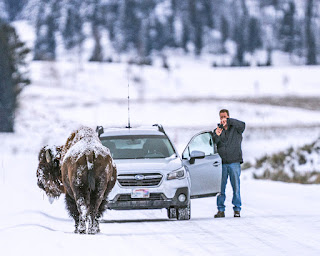For the past few years a group of friends have visited Yellowstone in the winter in hope of photographing the illusive wolves. This years the boys are going but since I am the elder statement and due to the COV-19 and been high risk, I will not be attending. Therefore they will return from the 2020 trip with photos packs of wolves making several kills.
Last year as in 2018
we were lucky to capture of the big horn sheep during the rut. In 2019 we found an area outside the park
where the sheep were congregated having orgy and not disturbed by the
on-lookers. The males measure each other
and have crossing of the weapons, rested and ate grass before they went for
another just.
When they got a scent
in the air of a female the chase started and there were no rules; all in love
and war is fair. The victim got chased by several males and assaulted but there
were always the other knights wanting to get the princess. No chivalry here…Sir
Lancelot was far away and Guinevere had to fend for her virtue. But eventually
she gets seduced in the fly.
Meanwhile Sir
Lancelot is at the castle wondering as to where his dame has gone. But the
other great predator raises his hands happy to have captured the action.
You always find moose
and are buffaloes the most numerous that one is tired of photograph but there
is always the itinerant bullfighter taking a shot at the approaching
beasts. The bison have very strong necks
that allow them to push the snow like bulldozers to get to the dry grasses
bellow. They move with the snouts buried in the snow as they move the heads
side to side by walking. These beasts are most majestic to photograph in the
winter because the contrast of the white snow and the dark brown hairs.
Coyotes are also
common and I noticed thru time after many visits, that they have habituated to
humans so they are easy to photograph. They develop a technique of walking in
the edge of the snow-plowed roads and when they hear a sound, stop, and jump
head first into the snowbank hoping to catch a mole…not too efficient since
they have to try several times.
During this trip I finally got a beautiful red fox in winter and this one gave me several poses; probably best photo of this trip. They also behave as the coyotes searching prey as they move under the snow--stop, listen and jump--many tries before they catch a meal.
The elk are ubiquitous and males’ moves in groups separate from the females who move younger ones. I would say that they have a roughest time in the winter searching for the scarce food and in constant alert from attack by the wolf packs. They are majestic animals and move with elegance in the snow.
Pronghorns move in herds and are usually shy and always moving around so there is no place in the park where they will always be found. These not the ones that I say when I see them “that’s OK, I get them later”. They will not be there next time so I shoot them when I see them.
These are traditional spots that I have photographed every time I visited in winter, my dying tree that I photographed for 10 years, the scarecrow snowman and the Trading Post. I will know from my friends if the tree is still standing.

































